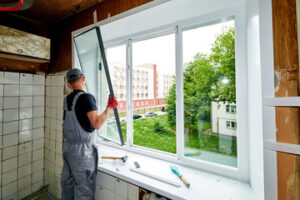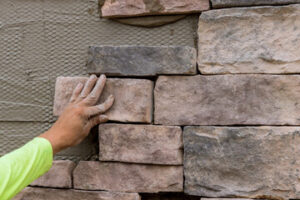Easton Replacement Windows can help increase your home’s energy efficiency and value. Here are a few things to consider before investing.

Make sure the replacement window is sized correctly for your window opening. This may require shimming. Remove these from the frame if the older windows had sash weight pockets. These are often made of lead and should be disposed of in an approved manner.
One of the main benefits homeowners get from replacement windows is improved energy efficiency. Unlike old, single pane windows that allow heat to escape during the winter and hot air to leak in during the summer, modern double- or triple-pane windows are well-insulated to keep your home comfortable year-round. This reduced heating and cooling demand lessens your home’s carbon footprint and helps to lower your energy bills.
Depending on the type of window and frame you choose, you may also be able to take advantage of federal tax credits that help to offset the initial investment. This means you’ll save money right away and enjoy the benefits of your new windows for years to come.
You can further increase your energy savings by selecting frames with low-emissivity coatings that help to reduce the transfer of heat and ultraviolet light rays between the window’s panes and the surrounding wall area. These coatings are available in a variety of colors to complement your home’s décor and help to improve the look and feel of your windows.
Properly installed replacement windows create a tight seal that prevents air leakage, which allows climate-controlled indoor air to stay inside and the outdoor air to stay outside. This not only reduces your energy costs but also reduces the amount of pollutants that enter your home, improving the overall air quality in your home and helping to improve your health.
Many new replacement windows are designed with a fusion-welded frame to provide greater structural integrity. This eliminates the possibility of warping, sagging or bowing over time. They’re also available with a wide range of options and upgrades to accommodate your specific tastes and needs, including between-the-glass blinds and grilles, decorative trim and hardware, screens and more.
Other features that can help to make your new windows more energy-efficient include argon gas between the window’s panes, which reduces heat transfer and obviates the need for a secondary glazing, as well as insulated sills and frame edges. You can even choose from a number of different window styles and finishes, such as vinyl, aluminum or wood composite, to meet your specific preferences.
Increased Home Value
The most obvious benefit of new replacement windows is their ability to increase your home’s resale value. Depending on the style you choose and other factors, it is possible to add up to 73% of the cost of your new windows to your home’s value when it comes time to sell. This is one of the best return on investments among home improvement projects.
Replacement windows are a great addition to any house and can be a huge selling point for potential buyers. When buyers walk into a house, the first impression they will make is of the windows. If your windows are old, outdated or in disrepair, they will leave a bad impression and may cause them to want to pay less than your asking price. New replacement windows will give your house a fresh, updated look that is sure to impress buyers and make them want to offer you more money for your home.
In addition to the aesthetic benefits, replacement windows can also make your home more secure. Old windows are more likely to allow criminals into the home, but new windows with strong frames and secure locks will deter crime and help keep your family safe.
When it comes to choosing the right window for your home, there are a variety of options available to fit any budget and taste. You can even save money on your new replacement windows by taking advantage of energy efficiency rebates that are offered by some local utilities. You can check the Database of State Incentives for Renewables and Efficiency to find out what energy efficiency incentives are available in your area. No matter your needs or budget, DaBella has a wide range of replacement windows to meet them.
Aesthetically Pleasing
Whether you’re looking for a modern minimalist vibe or timeless classic elegance, the right home windows offer a beautiful and functional connection between the interior of your house and its surroundings. With a wide array of window styles, customization options, and finishes to choose from, you’ll be able to upgrade your windows with a style that complements your home’s unique architectural design and aesthetic.
Replacing old, aging windows will elevate your property’s curb appeal, giving it a well-maintained and polished look that will leave a lasting impression on visitors and passersby. If you’re planning to sell your property in the future, a more visually appealing home will attract prospective buyers and potentially increase its market value.
Choosing eco-friendly materials for your replacement windows is another way to elevate the aesthetics of your home while aligning with the growing movement towards sustainable living. Explore a variety of energy-efficient options to reduce your home’s carbon footprint, such as double or triple-glazing and low-emissivity coatings.
The frame material and glass type you select for your new replacement windows will also play a role in their visual impact. Different frames are available in a variety of colors and finishes to suit any design preferences, while different glass options offer varying levels of privacy and light control.
Many homeowners opt to add decorative elements like grilles or muntins to their new windows for a more personalized aesthetic. You can even have your new windows customized with a unique design or message to make them a true one-of-a-kind feature in your property.
The key to a successful home improvement project is making informed decisions that align with your personal aesthetic aspirations and functional needs. When it comes to choosing a company to install your replacement windows, make sure they offer a wide range of customizable options, provide a record of successful projects, and engage in a thorough consultation process that will help them understand your unique needs and recommend the most suitable window solution for your home. This will help you achieve a seamless and efficient installation that will ensure the best possible results.
Better Noise Reduction
Whether traffic or barking dogs are interrupting your peace and quiet or you’re trying to stay focused on work projects, the right windows can make all the difference. Noise-reducing replacement windows are designed to reduce external noise pollution, creating a more peaceful and serene home environment for you and your family. They can also help you get a more restful night’s sleep, contributing to your overall health and well-being.
A number of factors contribute to the soundproofing capabilities of replacement windows. The type of glazing and material used plays a key role in their ability to block out noise. Typically, double-pane windows that include dense gasses like argon in between panes provide superior noise reduction compared to single-pane windows. Additionally, insulated frames that use closed-cell materials such as microcellular PVC and insulating foam will also be better at blocking out noise.
When shopping for sound-reducing windows, pay attention to their Sound Transmission Class (STC) rating. A higher STC rating indicates better noise reduction. In addition, the quality of the installation will also play a major role in how effective your new replacement windows are. The use of durable weatherstripping and sealant will minimize sound transmission through gaps or cracks around the frame.
Other features that may enhance your noise reduction include the type of spacer used and the thickness of the glass. A nonmetal spacer is more effective at dampening noises than metal spacers, while thicker glasses and varying the thickness of each pane can help disrupt sound waves of different frequencies.
Lastly, look for replacement windows with tight seals that prevent air leaks and noise infiltration. This is an important feature that can be influenced by the quality of your installer and their sealing techniques.
Modern replacement windows come in a variety of operating styles and materials. For example, you can find windows with a tilt and turn operation that provide versatile ventilation while still providing a good level of noise reduction. You can also find uPVC frames that provide superior insulation and other benefits, such as being fire-resistant and self-extinguishing. Additionally, you can choose a laminated glass option that provides added security and durability while enhancing your noise reduction.








